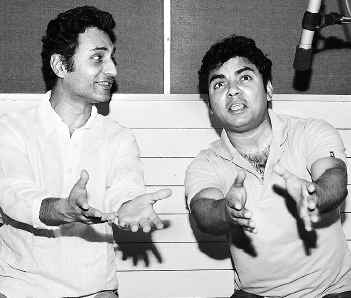 Stories for fun: Mahmood and Danish at a recording.
Stories for fun: Mahmood and Danish at a recording. Tales of magic and mystery
MITA KAPUR
Mahmood Farooqui and Danish Hussain on their attempt to revive a medieval art of storytelling."Yeh daaru bikau nahin hai," declares a woman. Sorcery, trickery, whoring and wining are a way of life. Mysterious rivers of blood and bridges of smoke flow through visible and invisible realms. Behind veils of darkness, wizards are kings and witches make wine and magic. Amar Aiyaar and Afrasiaab fight battles of wit and Aiyaari is a profession.
Kissas and Kahanis narrated by Mahmood Farooqui and Danish Hussain from Tilsim-e-Hoshruba transport you back in time — to a chowk in Lucknow anywhere between the ninth century and the 20th century.
Dastaangoi (46 volumes) encases the medieval art of storytelling. A dastaango could well be sitting on the steps of Jama Masjid or in a tavern narrating a kissa to an eager audience. You go back to being a child at your grandma's knee, rapt, eager to hear more.
Culture of the court
Strongly Persian in bent, it also used the idioms, language and culture from courtly life in Lucknow. Beginning from the 1880s, Dastaan-e-Amir Hamza was transcribed in Lucknow for about 20 years. Dastaangoi's dastaan slipped into river of silence. Danish felt, "It happened around early 20th century. Dastaangoi has a lot of subversive elements, it poked fun at the Islamic social hierarchy, talked freely about sex, wine, women in the market place, all taboo in Islamic society." According to Mahmood, "It's not simply the story of Dastaangoi, other forms of oral performances also went out of fashion. We can't say that it's because of the conversion from oral to print culture, since a lot of 19th century literary and print culture actually takes off from kissas and kahanis. The decline is inexplicable."
"Dastaans form the backbone of early Parsi theatre and Hindi cinema. There is a recasting of the religious and social order as well. Fantasy has always been considered children's literature. Now these barriers are being broken, it's seeing a revival finally."
Amid all the multi-layers, parallel worlds, fixing the unreal in the real for Mahmood comes with ease. "Dastaangoi is a case of mein kahani suna raha hun, aap baith ke suniye. Though broadly moral, it was written purely to entertain."
Danish (always the villain), explained, "There is no moral theme to these tales. It's not about who is going to win, it's about two sets of extra-witty people trying to outsmart the other. These are tales of good imagination, wholesome and entertaining." Mahmood spoke animatedly, "Dastaans appeal to us today not because they show us the world around us then but because they are fiction at their best. Their world may be far removed but we can still identify with aspects of it."
Likeable villains
"It casts a shadow over Hindi cinema. Gabbar Singh's antecedents are in there. A bloodthirsty character created by a filmmaker and you have Gabbar selling Glucose biscuits! Dastaans also have likeable villains who are still icons for Hindi cinema, although we need reams of study on the linkages. Dastaans are a kind of culmination of many centuries of oral storytelling forms, many structures flow from it."
Society now and the world then, connecting the two, Dan said, "It's all very grey. It's hard to distinguish at times where lies the evil and which side are the righteous people."
Balancing the polarities between Islamic tones and Dastaangoi's shock value, Mahmood said, "How can we typify Dastaangoi as Islamic? The many volumes of Dastaan-e-Amir Hamza were created in Urdu in Lucknow by non-Muslim and Muslim dastaangos. It can't be treated as Islamic literature."
"Among the entire gamut of characters, a minority are Muslim. How does it exactly dovetail with Islamism? Its Persian tones are no longer important in this century. Urdu poetry has diverged from Persian poetry. It is deeply rooted in North Indian poetic realms. Hafiz makes as much sense as does Anand Vardhan or Mir. You can't read Urdu poetry without reading Sanskrit theoreticians."
It's `masala entertainment', Mahmood felt, did not take away from the richness of the art form. "A dastaan has many shades to it. It's not like a finished product, a three-hour film or a novel. Different writers have added varying qualities to it." Dan is simpler, "Any art form is masala entertainment at the end of it. If it wasn't, it wouldn't be appreciated by the audience."
Says Mahmood, "The story of Amar Aiyaar capturing Afrasiaab keeps going on for eight volumes. Every time Afrasiaab sends a magician, he either gets killed or captured. It's an episodic formula on which it keeps building up. It's about constructing a story in which the plot vanishes. All you are left with is the telling of the story."
Favourite characters
As for their favourite character, Mahmood chooses Amar Aiyaar. "He is witty, sharp, flight-footed, basically a harami. Everyone loves to play that kind of a character. I have a sneaking sympathy for Afrasiaab, he keeps getting beaten up."
Dan added, "Aiyaar puts Dennis the Menace in the pale. Burk Firangi, an Englishman, is interesting. He's a trickster and he's lovable. Just as smart as a perfect sidekick should be, not smarter than his boss. An apt political comment on the great legendary sidekicks that our political leaders have."
About King Nausherwan's troubled dream, Mahmood says, "Dreams are unlimited. We need many more dastaangos in many more cities doing it in different styles for Dastaangoi to really take off as an art form. We cannot rise alone, for we can't sift grain from the chaff unless we have a body of work to choose from. That's our fundamental dream. We have 46 volumes.... so sooner or later the world is going to come to us."
http://www.hindu.com/mag/2006
No comments:
Post a Comment